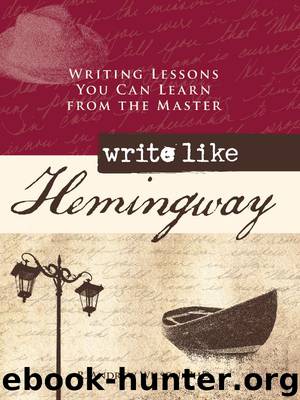Write Like Hemingway: Writing Lessons You Can Learn from the Master by R. Andrew Wilson

Author:R. Andrew Wilson [Wilson, R. Andrew]
Language: eng
Format: epub
Tags: ebook, book
Publisher: F+W Media, Inc.
Published: 2009-06-17T18:30:00+00:00
Taking the time given him from a canceled bullfight, Hemingway wrote “The Killers” in one Madrid afternoon. And as Papa himself told George Plimpton, he completed two other stories that day, “Ten Indians” and “Today Is Friday.” After first appearing in Scribner’s Magazine in 1927, “The Killers” was subsequently republished in a number of Hemingway collections: Men without Women (1927), The Fifth Column and the First Forty-Nine Stories (1938), and The Nick Adams Stories (1972). Hemingway gave permission for the players at the Rand School of Social Science to adapt it into a play version, and the story has provided the basis of several films. A 1946 film noir version, staring Burt Lancaster and Ava Gardner, closely followed Papa’s dialogue in its opening sequences. Reflecting on the film, Papa once commented that is was the only decent film adaptation ever done of his work. A later film version starred Lee Marvin, Angie Dickinson, and Ronald Reagan. Traces of the story’s signature dialogue—gangsters arguing over diner etiquette—can be seen in other films such as Reservoir Dogs (1992) or A History of Violence (2005).
Dialogue and Its Importance to the Story
Dialogue can serve a number of purposes within a story: it can drive the dramatic tensions between characters, set up the suspense elements of a plot, or establish believable characters. And knowing when characters should speak in a story—in addition to what they should speak about and how they should say it—is an important skill for an effective dialogue writer to have. Hemingway’s use of dialogue is so distinctive because of its powers of suggestion, such as a discussion between two characters about a bullfight that becomes a commentary on the sexual anxieties between them. The first step in understanding how Hemingway creates such tensions through dialogue is to see how those exchanges between characters are plotted within the story as a whole, from beginning to end. What purpose does a moment of dialogue serve at the opening of a story? At its climax? At its resolution?
To understand how Hemingway plotted specific moments of dialogue to serve the purposes of a story, let’s examine how he orders certain conversations at key moments of the “The Killers,” one of Papa’s series of short stories that follows the Nick Adams character. In it, two assassins have come to the town of Summit, Illinois, to carry out a hit on a retired boxer, Ole Andreson.
Papa Says Giving advice on writing to Carol, his younger sister, Hemingway warned against using adjectives such as “swell” to cover up the laziness of not thinking up proper words. “Try and write straight English,” Hemingway wrote, “never using slang except in Dialogue and then only when unavoidable.”71
Download
This site does not store any files on its server. We only index and link to content provided by other sites. Please contact the content providers to delete copyright contents if any and email us, we'll remove relevant links or contents immediately.
Asking the Right Questions: A Guide to Critical Thinking by M. Neil Browne & Stuart M. Keeley(5649)
Autoboyography by Christina Lauren(5184)
Eat That Frog! by Brian Tracy(4436)
Dialogue by Robert McKee(4323)
Sticky Fingers by Joe Hagan(4103)
Journeys Out of the Body by Robert Monroe(3572)
Annapurna by Maurice Herzog(3424)
Full Circle by Michael Palin(3389)
Schaum's Quick Guide to Writing Great Short Stories by Margaret Lucke(3321)
Elements of Style 2017 by Richard De A'Morelli(3307)
The Art of Dramatic Writing: Its Basis in the Creative Interpretation of Human Motives by Egri Lajos(3017)
Atlas Obscura by Joshua Foer(2900)
The Diviners by Libba Bray(2887)
Why I Write by George Orwell(2877)
In Patagonia by Bruce Chatwin(2876)
The Fight by Norman Mailer(2848)
The Mental Game of Writing: How to Overcome Obstacles, Stay Creative and Productive, and Free Your Mind for Success by James Scott Bell(2845)
Venice by Jan Morris(2526)
The Elements of Style by William Strunk and E. B. White(2442)
